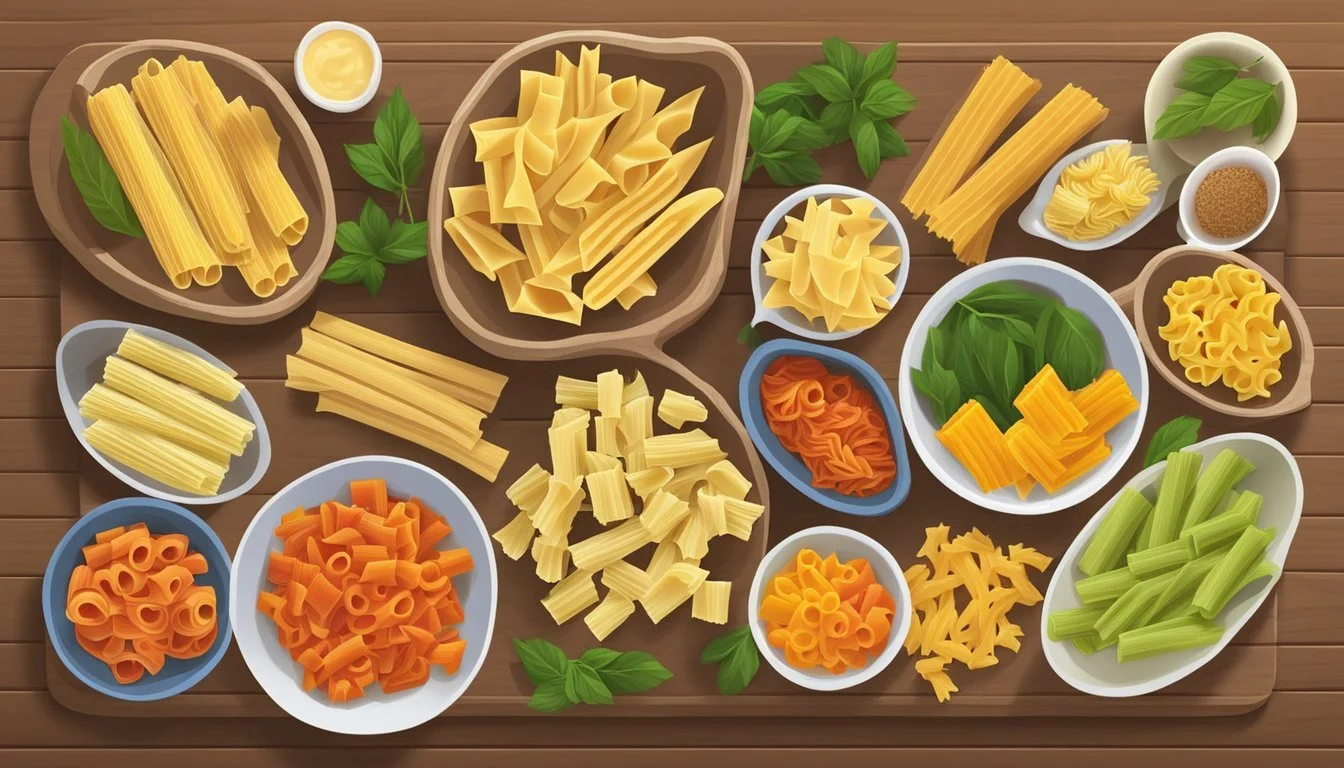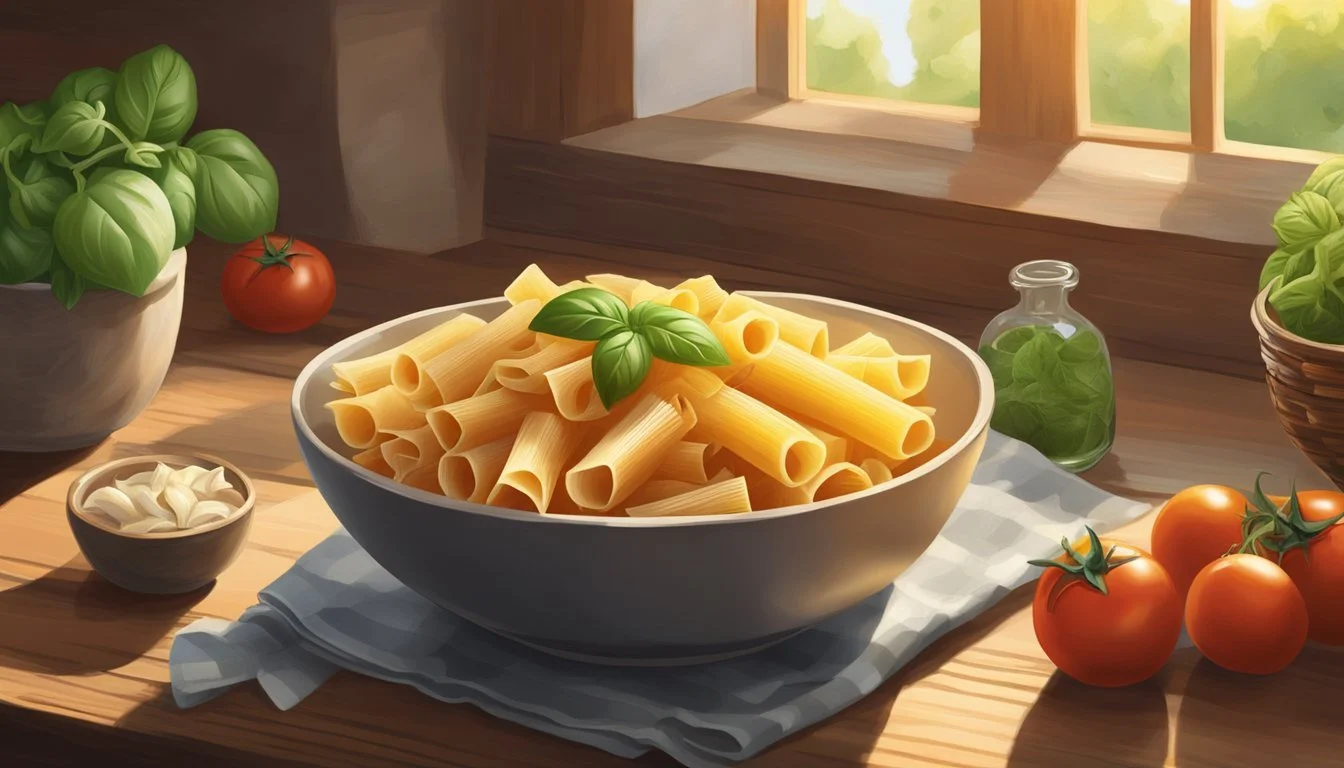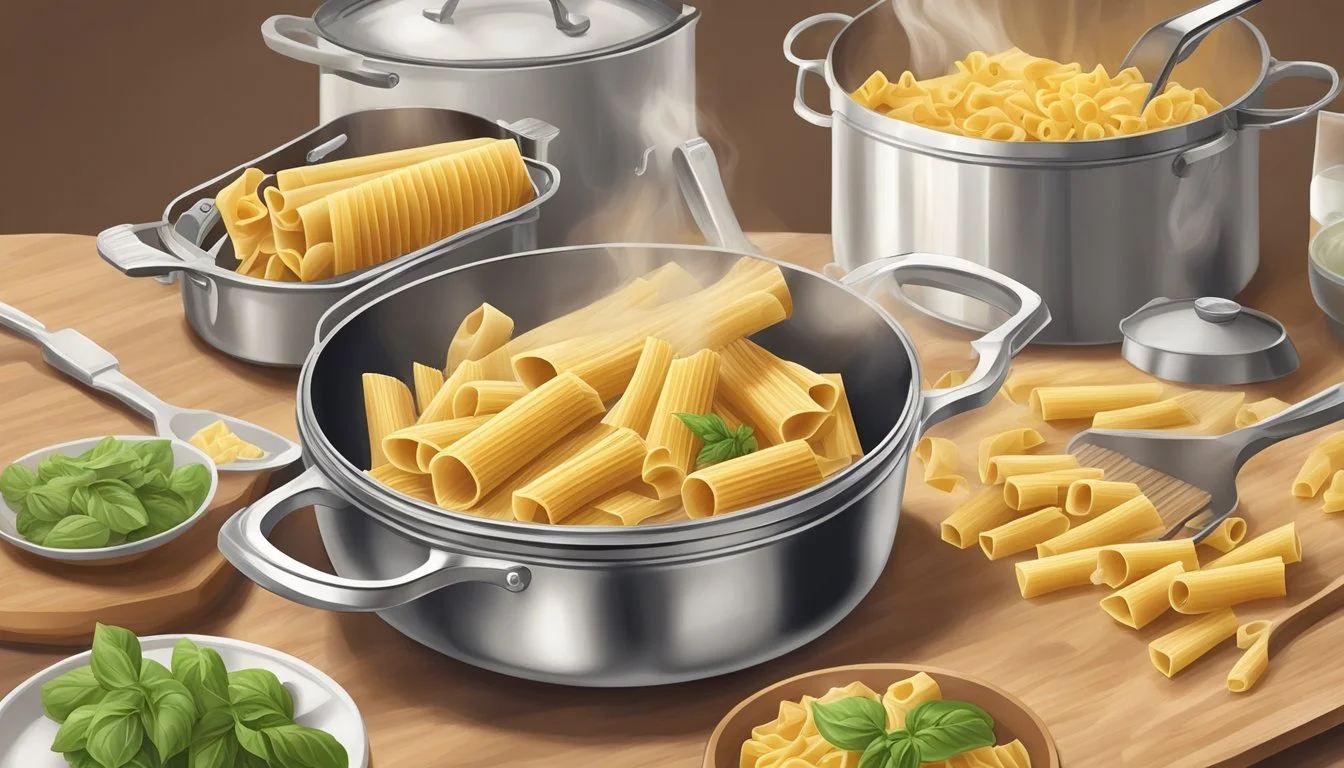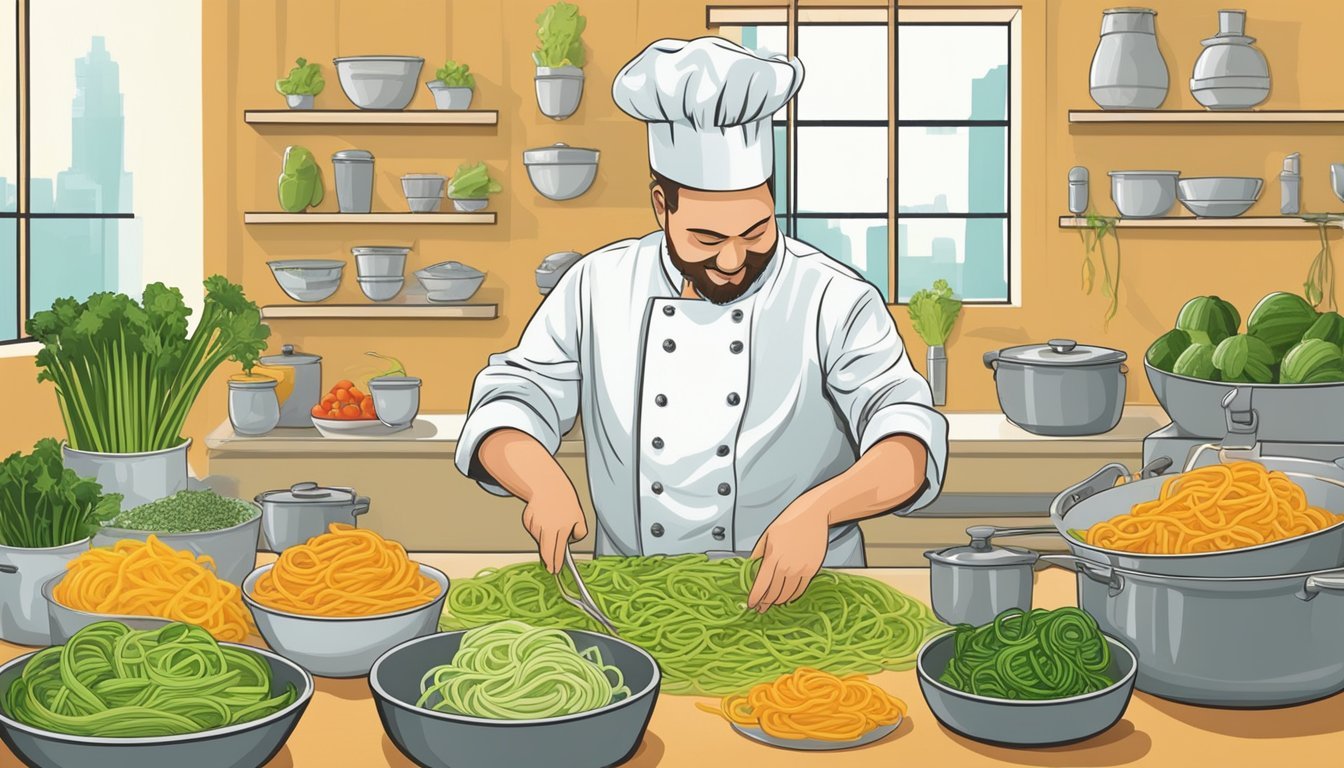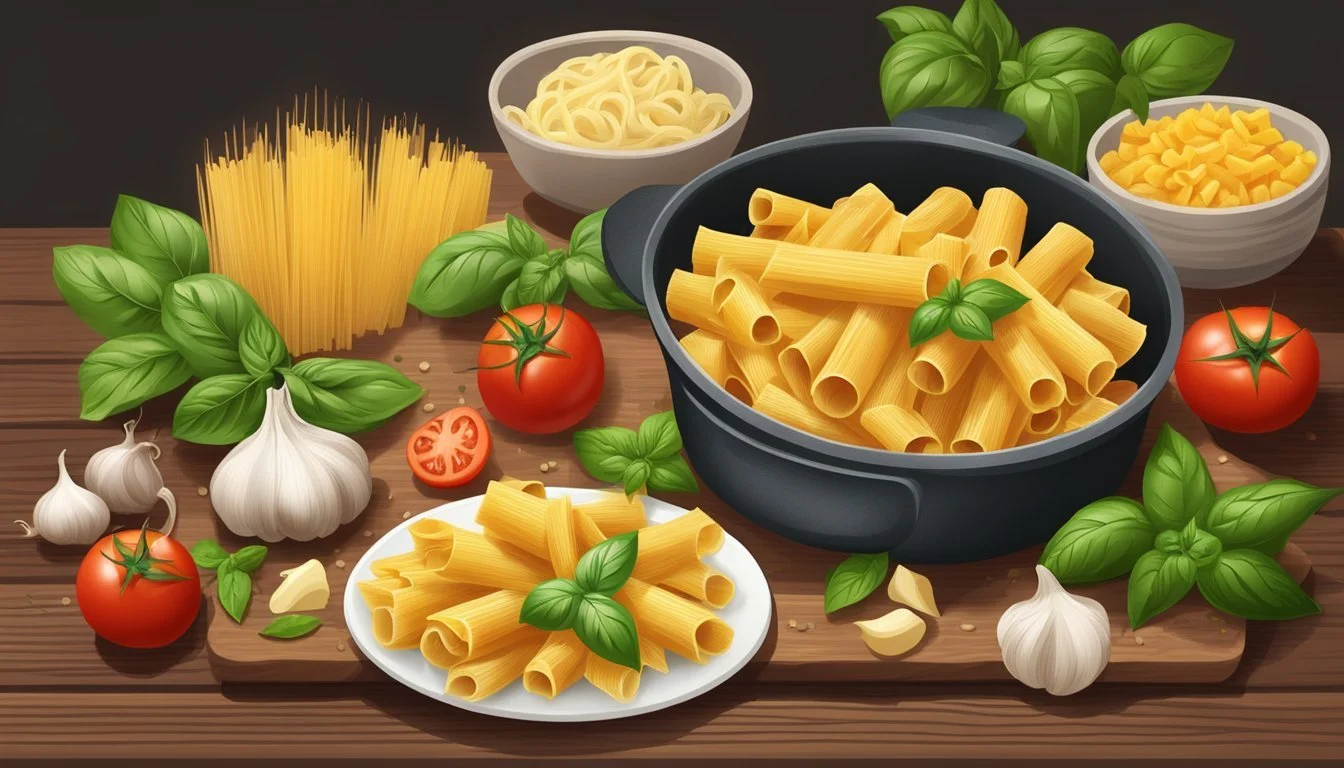Rigatoni Pasta Substitutes
Top Alternatives for Your Favorite Dishes
Rigatoni pasta, with its large tube shape and ridges, is a staple in many Italian dishes and beloved for its ability to hold robust sauces and get tangled with delicious cheeses in baked casseroles. However, when this particular pasta (What wine goes well with pasta?) is not available or someone is looking for a variation, there are several substitutes that maintain the integrity of traditional recipes while providing a similar culinary experience. Substitutes for rigatoni should ideally be tube-shaped to emulate the way rigatoni embraces sauces and ingredients.
Substitutes for rigatoni range from widely known pastas to less common variations that fulfill specific dietary requirements or taste preferences. Among the most common alternatives are penne and ziti, which are also tube-shaped pastas but with different textures and cut ends, allowing for a varied yet familiar texture in dishes. For those seeking a healthier option, whole wheat or gluten-free pasta varieties can replicate the rigatoni experience while aligning with nutritional goals. Choosing the right substitute depends on the recipe's requirements and the desired final texture and flavor of the dish.
When a recipe calls for rigatoni, but a suitable alternative must be used, it's important to consider the size, shape, and texture of the pasta substitute. The goal is to find something that will not only hold up in cooking but also complement the other ingredients in the dish. Each type of pasta brings its unique characteristics, and while no substitute will be an exact match for rigatoni, many can come close enough to make a satisfying and delicious meal.
Understanding Rigatoni Pasta
Rigatoni is an Italian pasta known for its large, tube-shaped form with signature ridges. These characteristics make it ideal for hearty sauces and baked pasta dishes (What wine goes well with pasta dishes?).
Traditional Uses and Pairings
Rigatoni pasta, originating from Italian cuisine, is a prime choice for rich and robust sauces. Its tube-shaped design and ridges are adept at holding onto sauces, ensuring flavor in every bite. Traditional pairings for Rigatoni include:
Marinara Sauce: The ridges of Rigatoni help to trap the sauce, enhancing the overall flavor.
Cheesy Pasta Bakes: The pasta's sturdy structure withstands baking without losing texture.
Meaty and Vegetable Sauces: Chunky sauces cling to the ridges, making Rigatoni an excellent carrier for these mixes.
Typically, sauces with a thicker consistency, like Bolognese or Alfredo, are preferred with Rigatoni due to the pasta's ability to retain and meld with the sauce.
Nutritional Information
Rigatoni pasta is made from durum wheat and water, providing a good source of fiber and complex carbohydrates. The nutritional content for a standard serving size of cooked Rigatoni (approximately 140 grams) includes:
Calories: 220 kcal
Total Fat: 1.3 g
Saturated Fat: 0.3 g
Cholesterol: 0 mg
Sodium: 4 mg
Total Carbohydrates: 43.2 g
Dietary Fiber: 2.5 g
Sugars: 1.4 g
Protein: 8.1 g
The appearance of Rigatoni pasta with its ridged surface is not just for aesthetic appeal but also contributes to its nutritional profile, as whole grain variations can offer higher fiber content. When consumed as part of a balanced diet, Rigatoni provides essential nutrients necessary for maintaining energy levels and supporting overall health.
Selecting Rigatoni Substitutes
Choosing an alternative for rigatoni requires considering pasta shapes that complement the intended sauce and cooking style. The ideal substitute shares similar characteristics in size, shape, and texture to maintain the integrity of the dish.
Criteria for Ideal Substitutes
When selecting a substitute for rigatoni, it's essential to match the size and shape of the original pasta to ensure it integrates well with the recipe. Rigatoni is tube-shaped with ridges and is typically served al dente. Substitutes should also have:
Similar thickness to hold up against creamy sauces and tomato-based sauces.
Comparable surface area to absorb flavors from olive oil, garlic, and other ingredients.
Ridges or grooves for clinging sauce and additives effectively.
The following table illustrates potential rigatoni substitutes:
Substitutes Size Shape Gluten-Free Option Penne Medium Tube-shaped Available Ziti Medium Tube-shaped Available Fusilli Small-Medium Spiral Available Gluten-Free Penne Medium Tube-shaped Yes
Sauces and Substitutes Compatibility
The choice of substitute impacts how well it pairs with different sauces:
Creamy Sauces: Select pasta like penne or ziti that can handle the weight and richness without becoming soggy.
Tomato-Based Sauces: Opt for options with ridges, such as fusilli, that can trap the sauce within its curves.
Olive Oil-Based: Lighter shapes like penne, despite being slightly narrower than rigatoni, are an apt choice as they mix well with olive oil-based dressings.
Texture plays a crucial role in sauce pairing. An al dente preparation allows the pasta to retain a firm texture, essential when it's substituted in a recipe designed for rigatoni, which also holds its texture well.
Popular Rigatoni Alternatives
Choosing the right pasta shape can change the texture and sauce interaction of a dish. For culinary enthusiasts who appreciate Italian pasta, finding a substitute for rigatoni that maintains the integrity of their culinary creations is key.
Penne: A Versatile Choice
Penne pasta, characterized by its tube-like shape and ridges, serves as an excellent substitute for rigatoni due to its ability to hold sauces on its surface. Often used in pasta dishes with various sauces, from chunky meat to lighter vegetable varieties, penne provides a versatile base that suits both vegetarian and Bolognese applications.
Ingredients pairing: Tomato sauce, cheeses, veggies
Ideal dishes: Pasta lovers can use penne in an array of Italian dishes, making it a go-to for hearty yet accessible meals.
Ziti: Ideal for Baked Dishes
Ziti pasta, recognized for its smooth, tube-like structure, is another suitable replacement, especially in baked dishes like the classic Baked Ziti. When layered with mozzarella cheese, herbs, and tomato sauce, ziti absorbs flavors beautifully and offers a textural experience similar to rigatoni.
Preparation note: For best results, one should slightly undercook ziti when it's meant for baking to prevent a mushy texture post-oven.
Elicoidali and Sedani: Closest Texture and Shape
For those adamant about finding a replacement with the closest texture and shape to rigatoni, Elicoidali and Sedani rise to the occasion. With their ribbed exteriors, they are adept at trapping and holding onto sauces, much like their counterpart.
Elicoidali: Works well in robust and chunky sauce-based dishes.
Sedani: Similar to celery stalks in shape, sedani is a prime choice when looking for a pasta with grooves to catch every bit of flavor.
Fusilli, a helical-shaped pasta, although not as close in resemblance, offers an interesting alternative for its delightful textures and sauce retention abilities, further highlighting the diversity of Italian pasta shapes as substitutes.
Herb and cheese affinity: Fusilli's spirals are perfect for lighter sauces and offer an exceptional bite when combined with a variety of herbs and cheeses.
Gluten-Free and Low-Carb Substitutes
Individuals following a gluten-free or low-carb diet need not abandon the comfort of rigatoni pasta dishes. Alternative options available provide comparable textures and flavors, while catering to nutritional requirements.
Zucchini Noodles: A Healthy Twist
Zucchini noodles, often referred to as zoodles, are a splendid gluten-free and low-carb alternative to traditional pasta. One can spiralize them into shapes similar to rigatoni for a satisfying bite. They are nutrient-dense and an excellent source of vitamins, with significantly fewer carbohydrates than whole wheat pasta. Zucchini noodles can effortlessly absorb flavors, making them ideal for robust sauces like Alfredo, and they work wonderfully in pasta salads.
Carb Comparison: Zucchini noodles contain 3-10 times fewer carbs than traditional pasta.
Nutrients: High in vitamins A and C, potassium, and antioxidants.
Cooking Tip: For a firmer texture, one may briefly sauté zoodles to evaporate excess moisture without overcooking.
Rice and Couscous: Alternate Grains
Substitutes like rice and couscous offer a delightful alternative with a firmer texture and nutty flavor profile, suitable for those pursuing gluten-free diets. Brown rice pasta, made of brown rice flour and water, is a gluten-free substitute that holds up well in heavier pasta dishes due to its sturdier texture. It contains nutrients often absent in refined flour pastas.
Gluten-Free Couscous: Made from rice or corn flour, adding a unique texture and flavor to pasta-like dishes.
Rice Pasta:
Net Carbs: Approximately 72g per 100g serving, better suited for gluten-free diets than low-carb.
Texture: Offers a firmer bite similar to al dente whole wheat pasta.
Flavor: Provides a subtle, nutty flavor.
The use of vegetables in place of traditional noodles not only offers a nutrient boost but also adds a creative twist to classic pasta dishes. Whether it is incorporating zucchini noodles for their versatility or opting for rice pasta due to its familiar format, these options ensure that dietary restrictions do not limit culinary exploration.
Making Substitutes Work in Your Recipes
When replacing rigatoni pasta in a recipe, the cook should consider how the substitute will interact with cooking times, techniques, and the flavor profile of the dish.
Adjusting Cooking Times and Techniques
Different pasta shapes and materials come with varying optimal cooking times and techniques. It's crucial to not overcook substitutes as textures vary and some may become mushy. For example, if one opts for Penne, it should be boiled until it is al dente—cooked to be still firm when bitten. This typically takes around 10-12 minutes. When preparing pasta salads, the pasta can be slightly undercooked as it will continue to soften when mixed with the dressing.
Boiled: Substitute pasta may require shorter or longer boiling times.
Sautéed: If finishing in a sauce, consider less boiling time so the pasta can absorb flavors while simmering.
Flavor Pairings and Adjustments
Rigatoni's large tubes hold onto chunky meat sauces and marinara well. Substitutes should complement these pairings. Additionally, seasonings such as salt and pepper always enhance the dish's flavor profile. One should adjust these seasonings after the pasta has been incorporated into the dish to ensure the right balance.
Cheeses: Strong cheeses like Parmesan should be freshly grated and added over the dish.
Herbs: Fresh herbs such as basil should be torn and scattered on top for maximum flavor.
Olive Oil: A drizzle of quality olive oil can significantly enhance the dish before serving.
Vegetables: If vegetables are used, they must be cut to match the size of the pasta substitute to ensure a harmonious bite.
In summary, successful substitution requires consideration of the pasta's role in the dish, how it interacts with the other ingredients, and the desired final texture.
Creative Culinary Innovations
Exploring the world of pasta substitutions not only caters to dietary preferences but also opens the door to innovative takes on classic dishes. These culinary creations often marry traditional textures with unexpected flavors.
Fusion Dishes with Pasta Substitutes
Substituting rigatoni with alternative pasta forms can lead to the creation of unique fusion dishes. A Pasta Bake infused with Asian flavors is one such innovation. Instead of rigatoni, one might use shirataki noodles or soba to absorb a blend of soy sauce, sesame oil, and spices. Imagine a casserole featuring delicate noodles, umami-rich Italian sausage, and crisp vegetables like bell peppers and onion.
Another innovative substitute involves using spiralized vegetables, such as zoodles, in a dish that unites Italian Cuisine with Mediterranean elements. Zucchini noodles can be layered with tomato paste, ground beef, or lamb, incorporating aromatic herbs like basil and mint to create a baked dish that is both fresh and hearty.
Innovating Traditional Pasta Salads
When reimagining Pasta Salads, swapping out rigatoni for lighter options can bring a nutritious twist to the table. Consider using quinoa or chickpea pasta as a base, which not only enhances the nutritional profile but also introduces new textures.
Substitute Characteristics Best Paired With Quinoa High-protein, gluten-free Fresh vegetables, vinaigrette Chickpea Pasta High in fiber, gluten-free Robust Italian dressing, olives Couscous Light, fluffy texture Diced cucumber, lemon juice, feta
Layering these bases with vibrant bell peppers, tangy onion, and fresh basil transforms a traditional salad into a delightful, health-conscious meal. Adding a protein such as grilled chicken or flaked salmon can make these salads the centerpiece of a nutritious and satisfying meal.
Conclusion
When a pasta lover seeks an alternative to rigatoni, they have numerous options to explore. Substitutes range from penne, which shares a similar tubular shape but differs with its pointed ends, to farfalle, also known as bow-tie pasta, offering a delightful texture that holds sauces robustly. To accommodate dietary preferences, options like brown rice pasta, kelp noodles, or even vegetable-based options like spiralized zucchini can be excellent choices.
For those who enjoy the convenience of an Instant Pot, substitutes should be selected based on how well they maintain their texture under pressure. Penne, for example, stands up well and can be a direct substitute in many Rigatoni Pasta Recipes suited for Instant Pot cooking.
Substitute Texture Instant Pot Friendly Penne Firm, ridged Yes Farfalle Firmer texture Moderate Brown Rice Pasta Softer texture No Kelp Noodles Chewy, slippery No Zucchini Noodles Soft, delicate No
Substitutes should not only complement the flavors but also coincide with the desired cooking method to retain a semblance of the original dish's character. Ultimately, the choice of substitute hinges on personal preference, dietary requirements, and suitability for the cooking appliance at hand.

